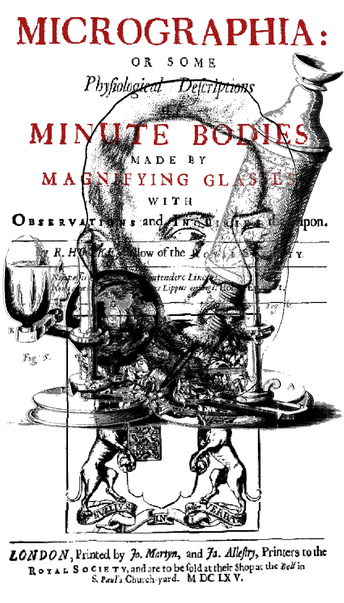Robert Hooke1635–1703
Cells were so named by Hooke in his Micrographia (1665), the title page of which is shown together with his compound microscope, when he observed the structure of sections of cork under the microscope. It is doubtful whether any portrait of Hooke is still extant; the one shown has been described as of him although it is difficult to sustain this attribution. In his role as curator of experiments of the Royal Society, Hooke conducted a bewildering array of observations and drew upon these in his books. One such involved measuring visual resolution. He gave a demonstration to a meeting Fellows of the Royal Society in which he determined whether they could distinguish a separation of less than one minute of arc; in general they could not. Independently of Franciscus Maria Grimaldi (1613-1663) and at about the same time (1675), Hooke examined diffraction produced by placing a razor’s edge in the path of a narrow beam of sunlight. He described the bands that were visible in the shadow region but he did not remark on any colours seen in them. Some years earlier, in his Micrographia, he had noted the coloured rings in thin transparent films and interpreted them in terms of vibrating pulses of light. He also speculated that the vibrations were transverse to the direction of propagation, and that the waves were like those generated by a stone dropped in water. Hooke’s analysis of colour was in the Aristotelian modificationist tradition: all colours were a modification of white light. In the case of thin films, the colours were a consequence of “confusions” in the reflections and refractions of white light. Nonetheless, Hooke’s pulse theory of light, and his belief in the universal nature of vibrations, is considered to be a precursor of wave theories. Together with Christiaan Huygens (1629-1695) he was a critic of Newton’s analysis of prismatic colours, as well as his theory of light. Diffraction was analyzed in terms of the wave fronts originating at an edge and his wave theory was contrasted with Newton’s corpuscular theory of light. Like Descartes, Hooke was exercised by difficulties involved in astronomical observations and drew attention to the fact that it is impossible to see with the naked eye structures on the moon that can be seen with the aid of a telescope. In order to assess the value for visual acuity he described both a stimulus and a procedure for determining it. The stimulus he used was equivalent to a square-wave grating; the procedure was the time-honoured one of increasing the distance of observation until the lines of the grating could not be discriminated from one another. Hooke was also an architect and a natural philosopher, and he was a prime mover in the surveying and rebuilding of London after the Great Fire of 1666.
